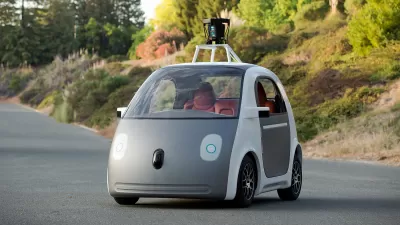An op-ed describes some of the not-so-hard to imagine drawbacks of a world full of a world full of self-driving cars.

It seems that many urban planners are presuming that automated vehicles will be a positive step toward a sustainable more livable urban environment. Their hypothesis is that these vehicles will undermine the motivation to own personal vehicles, resulting in travel decisions based on fully allocated costs and, subsequently, travelers more frequently favoring alternatives to the personal auto. Moreover, millennials and subsequent cohorts will not be burdened by or biased by the capital cost of vehicle ownership and parking and will instead deploy those funds on a variety of purposes, perhaps even diverting some of those savings to the higher housing costs characteristic of urban centric locations.
The thinking goes that having a fleet of automated vehicles at one’s beck and call will diminish the need to own a vehicle and could result in greater use of alternative non-motorized modes, public transportation, and most probably environmentally efficient automated vehicles. Some planners have gone so far as to envision freed up parking enabling denser urban areas or parking spaces being converted to urban green space or pedestrian facilities. And all will be good and we will have a green future.
This vision is very compatible with that of the technology and financial industries that appear to be envisioning the substantial household spending on travel (approximately 17 percent of household spending—plus, of course, business spending on transportation) as the next target opportunity for technology industries. Their interest is also in the green—the color of money green. The massive global transportation industry fuels visions of billion and trillion dollar opportunities waiting to be captured by the deployment of technology and the leveraging of logistics.
I was thinking about this on my way to the office this morning. My flying car was in the shop so I took my Segway to the maglev line —no, wait, Segways, flying cars, and maglevs haven’t deployed as prophesied by prior generations of technology innovators. But smart cars are right around the corner because Google told me so. Lest we get distracted by debating how far away that corner is, let’s speculate a little more on what it might mean to urban planning. After all we are in the giddy speculative phase where there are no wrong answers and it is both fun and sometimes a little scary to speculate on how emerging technologies might impact things. And there is that very human tendency to bias those visions to match our preferred outcomes.
Interestingly, the automated vehicle vision comes with stark contrasts. Take specifically the land use impacts. The planners' vision might be characterized by the image below. Mobility services enable lower car ownership , which particularly helps urban residents, who take advantage of alternatives and thrive in the urban lifestyle so commonly envisioned by urban planners. This scenario has more livable urban areas with fewer vehicles and the prospect that the reduction in space and resources committed to vehicles can be redeployed for a more robust urban area.
But a scenario perhaps more consistent with urban economic theory and empirical evidence on suburbanization might suggest that the lessened disutility of travel time when not personally driving and the prospects for lower travel cost by virtue of sharing at least the capital asset cost of the vehicles, and perhaps also the operating costs of trips, will result in greater travel. Individuals will maximize their own utility, which might include taking advantage of lower cost, more distant residential opportunities or choosing the opportunity to reside near that waterfront, forest, golf course, hobby ranch, or hillside vista that was too far away when one had to drive.
Scenarios regarding the impact of automation on vehicle miles of travel (vmt) are equally disparate. The benign scenario envisions the convenience of ridematching and ridesharing resulting in the modest average vehicle occupancy of 1.67 (less than half of the four or five seats available in most vehicles are typically full) giving way to higher occupancies. An increase in occupancy to only 2.0 could produce an approximate 20 percent reduction in vehicle miles of travel, and Googles bubble cars have created the expectation of small energy efficient electrically propelled vehicles. Occupancies beyond that could further reduce vehicle miles of travel. The contrary scenario has visions of empty vehicles shuttling around, accumulating VMT as they seek their next customer or shuttle between parking and active deployment. While not having to drive is a delight for some travelers, one of the tradeoffs is sharing the vehicle and dealing with the trip circuity, travel time reliability, and space sharing inherent while trying to capture the savings of shared travel with strangers. You may worry less about accidents but more about getting in a vehicle during flu season that has already shuttled a few dozen trips earlier in the day. The extent to which ridesharing and diversion of travel from auto modes can offset induced travel and deadhead miles as fleets are redeployed remains to be seen. The temporal and geographic trip distribution patters, the extent of vehicle type specialization (storage space, number of seats to accommodate various party sizes, mobility impaired accessibility, child safety seating etc.), and the number of competing services could all affect the logistic efficiency of automated vehicle deployment. The net impact remains highly speculative. There is much that remains unknown about how automated or connected vehicles will impact behaviors.

Imagine it is nearing Christmas in 2035, a “Generation Z” or “Founders” generation (the latter, the name for those born post 2000 who are tasked with fixing the mistakes of the millennial generation) couple decides to venture to the suburbs for a holiday dinner party with friends. Their two-year old, being babysat by an older teenager who lives in their building, contently watches holographic cartoons in their downtown condo. They e-hail their mobility service and their Goofmobile (the mobility service started by Google and Ford several decades earlier) picked them up and then deviates a few miles to pick up another couple heading to the burbs. As Jane recalls that she left her dessert tray on the counter, she queries the dispatch computer about returning home to retrieve her desserts, but she is told that another car would be dispatched to get the desserts. It will arrive on time but their account will be debited for the second trip for just desserts.
The party is delightful with the brisk December air motivating their host to cash in his annual fireplace fire permit to enjoy a rare, real fire. As the evening winds down the beautiful sight of large soft snowflakes filled the air and quickly blanketed the landscape in a beautiful scene reminiscent of many a Christmas card. The tranquility of the evening is interrupted as various guests' smart phones beep. Smiles fade as the mobility service provider informs customers that automated vehicle operations are no longer functional in the wet heavy snow, so their trips will be rescheduled for a later time when atmospheric and roadway conditions are adequate. The young couple panics—with their young child in the care of an 18-year-old and no way to get home. The host squirms with visions of guests crashing in his family room, reminiscent of college kids on spring break. Then a smile crept across his face as he remembers the all-wheel drive SUV in his garage, a remnant from his father’s estate that he has not yet disposed of. And the new law outlawing human-driven vehicles isn't due to take effect until New Year's Day 2036. Within a few minutes the first load of anxious partygoers ventures out into the winter wonderland as snow billowed and the strange sounds of a turbocharged V-6 internal combustion engine and the crunch of snow packing under wheels filled the quiet night. An older gentleman in a stranded automated bubble car flags them down and climbs in the crowded vehicle, thankful for a ride to safety.

As in most things in life, the future holds the promise of change, and with that many benefits as well as unknowns and unintended consequences. Planners, policy makers, and industry professionals with input from the public should strive to find ways to realize the positive benefits of technology without ego, greed, self-interest, lust for power, or incompetence denying the public the full benefits of new technologies. And planners should be cautious and avoid presumptiveness, as the path ahead promises to be exciting, but also, inevitably uncertain and challenging.
Happy Holidays!
The opinions are those of the author—or maybe not—but are intended to provoke reflection, and do not reflect the policy positions of any associated entities or clients. [email protected].

Depopulation Patterns Get Weird
A recent ranking of “declining” cities heavily features some of the most expensive cities in the country — including New York City and a half-dozen in the San Francisco Bay Area.

California Exodus: Population Drops Below 39 Million
Never mind the 40 million that demographers predicted the Golden State would reach by 2018. The state's population dipped below 39 million to 38.965 million last July, according to Census data released in March, the lowest since 2015.

Chicago to Turn High-Rise Offices into Housing
Four commercial buildings in the Chicago Loop have been approved for redevelopment into housing in a bid to revitalize the city’s downtown post-pandemic.

Google Maps Introduces New Transit, EV Features
It will now be easier to find electric car charging stations and transit options.

Ohio Lawmakers Propose Incentivizing Housing Production
A proposed bill would take a carrot approach to stimulating housing production through a grant program that would reward cities that implement pro-housing policies.

Chicago Awarded $2M Reconnecting Communities Grant
Community advocates say the city’s plan may not do enough to reverse the negative impacts of a major expressway.
City of Costa Mesa
Licking County
Barrett Planning Group LLC
HUD's Office of Policy Development and Research
Mpact Transit + Community
HUD's Office of Policy Development and Research
City of Universal City TX
ULI Northwest Arkansas
Town of Zionsville
Write for Planetizen
Urban Design for Planners 1: Software Tools
This six-course series explores essential urban design concepts using open source software and equips planners with the tools they need to participate fully in the urban design process.
Planning for Universal Design
Learn the tools for implementing Universal Design in planning regulations.



























